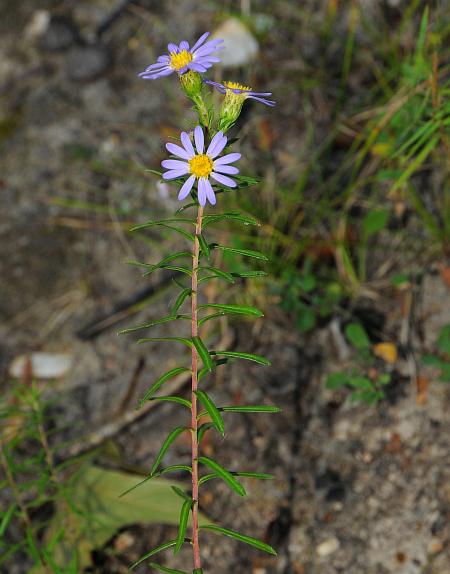Ionactis linariifolia (L.) Greene
Stiff Aster

Native
CC = 9
CW = 5
MOC = 34
© SRTurner
Ionactis linariifolia (L.) GreeneStiff Aster | |
 |
Native CC = 9 CW = 5 MOC = 34 |
© SRTurner |
|
Family - Asteraceae/Astereae Habit - Perennial forb with a short, thick, somewhat woody rootstock, rarely also with slender rhizomes. Stems - Erect or ascending, sometimes from a spreading base, to 50 cm, single or multiple, usually unbranched, thin, sometimes with fine, longitudinal lines, nearly glabrous or sparsely pubescent with minute, curled hairs toward the base, moderately to densely and minutely hairy toward the tip.
Leaves - Alternate, simple, sessile, numerous and uniform in size and spacing. Basal leaves absent at flowering. Blades 1-4 cm long, 0.5-4 mm wide, linear or very narrowly oblong-oblanceolate, stiff and somewhat leathery, narrowed or short-tapered to a sharply pointed tip, abruptly rounded to a nonclasping base, the margins entire, the surfaces glabrous, the upper surface often somewhat shiny, the margins strongly roughened with moderate to dense, minute, stiff, triangular hairs.
Inflorescence - Solitary heads, racemes, or occasionally branched and appearing as rounded to flat-topped panicles of up to 30 heads, the heads nearly sessile to long-stalked. Bracts relatively dense, 0.3-1.2 cm long, herbaceous but noticeably shorter than the adjacent leaves, linear.
Heads - Radiate. Involucre 6-9 mm long, 4-5 mm in diameter, cup-shaped to somewhat obconical. Involucral bracts in 4-7 unequal, overlapping series, oblong-lanceolate to lanceolate-triangular, the tip ascending, with a thickened, slender, green central band that is broadened and narrowly elliptic toward the tip, the broad, lighter margins often with a purple border, especially toward the tip, the margins appearing finely hairy, especially toward the tip, the outer surface glabrous. Receptacle flat or shallowly convex, with minute, irregular ridges around the concave attachment points of the florets.
Flowers - Ray florets 6-20, pistillate, the corolla 5-12 mm long, lavender to purple. Disc florets 20-40, perfect, the corolla 4-7 mm long, relatively deeply lobed (0.3-0.7 mm), yellow, sometimes turning reddish purple after the pollen has been shed, not persistent at fruiting. Pappus of the ray and disc florets similar, of 2 types, an inner series of numerous finely barbed bristles 4-7 mm long, these not broadened toward the tip, and an outer series of fewer but still relatively numerous bristles 0.2-0.8 mm long, both series straw-colored to light orangish tan.
Fruits - Achenes 2.0-3.5 mm long, narrowly obconical, somewhat 4-6-angled, the angles with yellowish brown ribs, densely silky-hairy, dark brown to purplish brown. Flowering - August - November. Habitat - Mesic to dry upland forests (usually on rocky slopes), savannas, ledges of bluffs, margins of glades, roadsides. Usually on acidic substrate. Origin - Native to the U.S. Lookalikes - Broadly, several members of the Symphyotrichum genus. Other info. - This little species can be found in the southeastern third of Missouri. Beyond Missouri it occurs in several distinct regions across the eastern U.S., most abundantly in Atlantic coastal states. The plant is easily identified by its narrow, deep green and somewhat shiny leaves, which are numerous and appear somewhat whorled on the stem. The heads look very similar to those of genus Symphyotrichum, with involucres which are noticeably large for an otherwise diminutive plant. The species can be abundant in areas agreeable to its growth, but it does appear to have a relatively stringent requirement for acid substrate. Steyermark noted that this species, though small in stature, was an attractive addition to rock gardens if provided acidic soil. It is available through some native plant nurseries. Photographs taken in Conecuh National Forest, AL., 10-23-04, and at Fort Benning, GA., 10-12-05 (DETenaglia); also at Taum Sauk State Park, Iron County, MO, 9-19-2012, Caney Mountain Conservation Area, Ozark County, MO, 9-24-2017, and along a roadside east of Cherokee Pass, Madison County, MO, 10-5-2021 (SRTurner). |